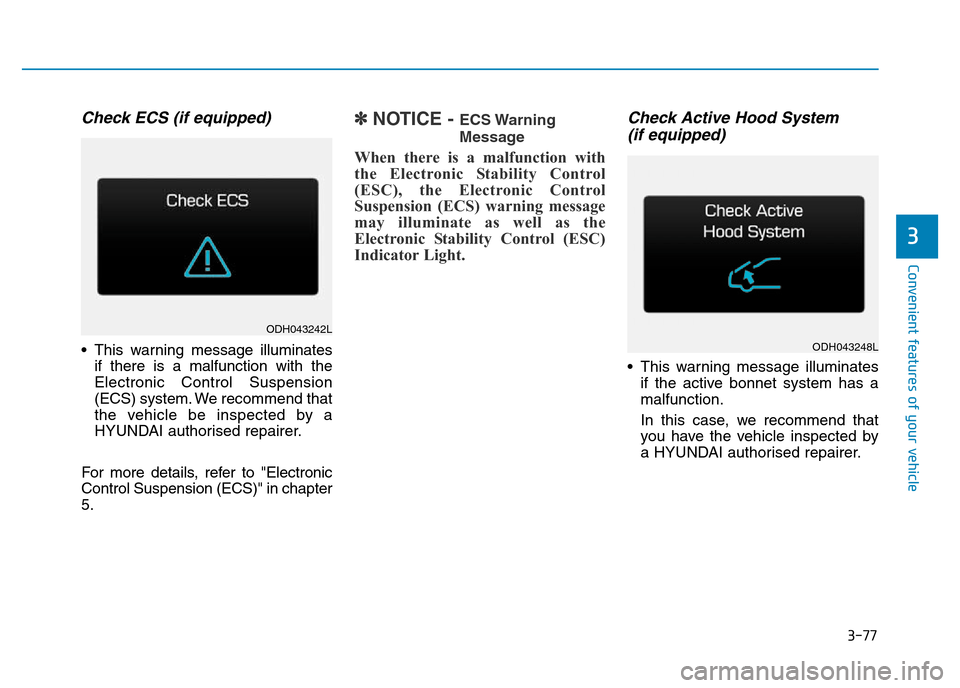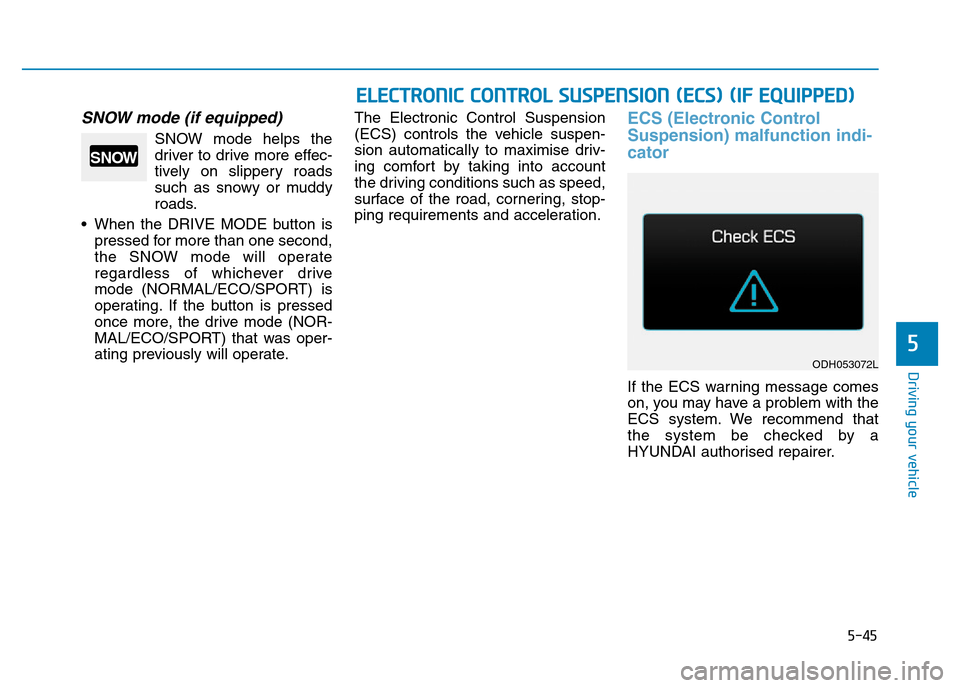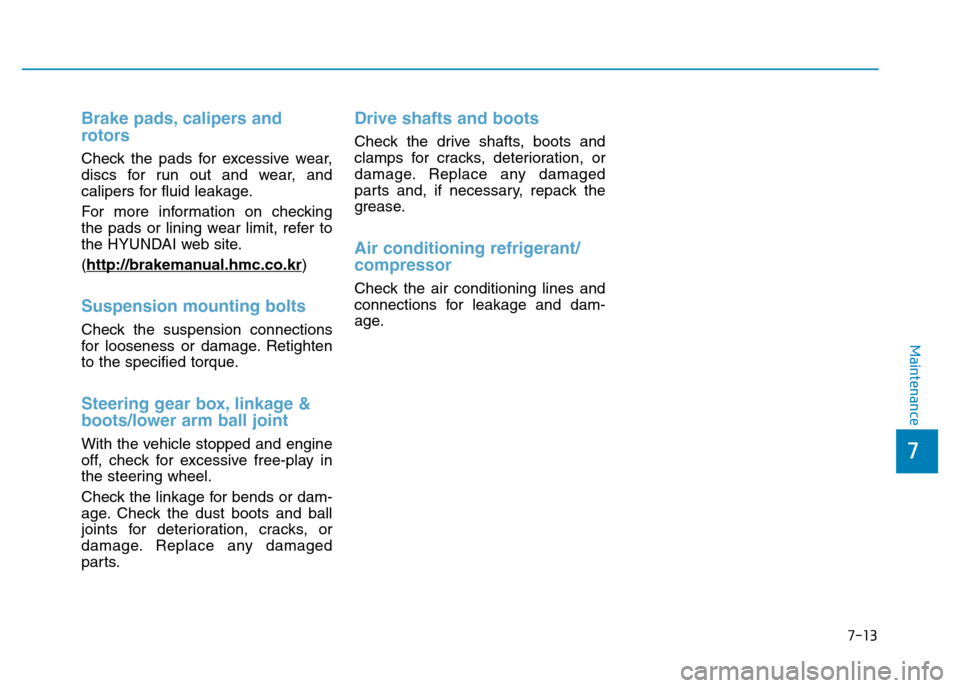2016 Hyundai Genesis suspension
[x] Cancel search: suspensionPage 152 of 502

3-61
Convenient features of your vehicle
3
To reset the service interval to the
mileage and days you inputted before:
- Activate the reset mode by press-
ing the OK button for more than 5
second, then press the OK button
again for more than 1 second.
Service in OFF
If the service interval is not set,
"Service in OFF" message is dis-
played on the LCD display.
✽NOTICE
If any of the following conditions
occurs, the mileage and days may be
incorrect.
- The battery cable is disconnected.
- The fuse switch is turned off.
- The battery is discharged.
Warning Message
If one of followings occurs, warning
messages will be displayed on the
information mode for several seconds.
- Malfunction of below systems
• Blind Spot Detection (BSD)
• Pre-safe Seat Belt (PSB)
• Electronic Control Suspension
(ECS)
• Tyre Pressure Monitoring System
• Autonomous Emergency Braking
• Advanced Smart Cruise Control
• Haptic Steering Wheel
• Lane Keeping Assist System (Lane
Departure Warning System)
- Low washer fluid
- Low fuel etc.
ODH043405L
Page 168 of 502

3-77
Convenient features of your vehicle
3
Check ECS (if equipped)
• This warning message illuminates
if there is a malfunction with the
Electronic Control Suspension
(ECS) system. We recommend that
the vehicle be inspected by a
HYUNDAI authorised repairer.
For more details, refer to "Electronic
Control Suspension (ECS)" in chapter
5.
✽NOTICE - ECS Warning
Message
When there is a malfunction with
the Electronic Stability Control
(ESC), the Electronic Control
Suspension (ECS) warning message
may illuminate as well as the
Electronic Stability Control (ESC)
Indicator Light.
Check Active Hood System
(if equipped)
• This warning message illuminates
if the active bonnet system has a
malfunction.
In this case, we recommend that
you have the vehicle inspected by
a HYUNDAI authorised repairer.
ODH043242L
ODH043248L
Page 183 of 502

3-92
Convenient features of your vehicle
This warning light remains on after
blinking for approximately 60 sec-
onds or repeats blinking and turns
off at the intervals of approximately
3 seconds:
• When there is a malfunction with
the TPMS.
In this case, we recommend that
you have the vehicle inspected by
a HYUNDAI authorised repairer as
soon as possible.
For more details, refer to “Tyre
Pressure Monitoring System
(TPMS)” in chapter 6.
Autonomous
Emergency Braking
(AEB) Warning light
This indicator light illuminates:
• When there is a malfunction with
the AEB.
In this case, we recommend that you
have the vehicle inspected by a
HYUNDAI authorised repairer.
Master Warning Light
This indicator light illuminates:
• When there is a malfunction on the
pre-safe seat belt, electronic con-
trol suspension, or advanced smart
cruise control or other systems etc.
To identify the details of the warn-
ing, look at the LCD display.
Safe Stopping
•The TPMS cannot alert you to
severe and sudden tyre dam-
age caused by external factors.
•If you notice any vehicle insta-
bility, immediately take your
foot off the accelerator pedal,
apply the brakes gradually with
light force, and slowly move to
a safe position off the road.
WARNING
Page 274 of 502

Driving your vehicle
Before driving.........................................................5-4
Before entering the vehicle ...........................................5-4
Before starting...................................................................5-4
Engine Start/Stop button ................................................5-5
Automatic transmission .......................................5-11
Automatic transmission operation .............................5-11
Parking ...............................................................................5-17
Good driving practices ...................................................5-17
All wheel drive (AWD) .........................................5-19
Using All Wheel Drive (AWD) .......................................5-19
Emergency precautions .................................................5-21
Braking system ...................................................5-23
Power brakes ..................................................................5-23
Disc brakes wear indicator ..........................................5-24
Foot parking brake ........................................................5-24
Electric parking brake (EPB) ........................................5-26
AUTO HOLD .....................................................................5-31
Anti-lock Brake System (ABS) ....................................5-35
Electronic Stability Control (ESC)................................5-37
Hill-Start Assist Control (HAC) ...................................5-40
Emergency Stop Signal (ESS) .....................................5-41
Good braking practices..................................................5-42
Drive mode integrated control system .............5-43
Electronic control suspension (ECS).................5-45
ECS malfunction indicator.............................................5-45
Autonomous emergency braking (AEB) ............5-46
AEB operation ..................................................................5-47
To cancel the AEB ..........................................................5-48
Malfunction indicator.....................................................5-49
Cruise control .......................................................5-51
Cruise control operation................................................5-51
Advanced smart cruise control system ............5-55
To convert to cruise control mode .............................5-56
Smart cruise control speed ..........................................5-56
Cancelled automatically .................................................5-59
Smart cruise control vehicle-to-vehicle distance.....5-61
Sensor to detect distance to the vehicle ahead .....5-63
Limitations of the system .............................................5-65
Lane departure warning system (LDWS) .........5-70
LDWS operation...............................................................5-71
Warning indicator ..........................................................5-72
Lane keeping assist system (LKAS) ..................5-74
LKAS operation ................................................................5-75
LKAS malfunction............................................................5-80
LKAS function change ..................................................5-81
Blind spot detection system (BSD) ...................5-83
BSD (Blind Spot Detection) /
LCA (Lane Change Assist) .............................................5-84
RCTA (Rear Cross Traffic Alert) ..................................5-87
5
Page 318 of 502

5-45
Driving your vehicle
5
SNOW mode (if equipped)
SNOW mode helps the
driver to drive more effec-
tively on slippery roads
such as snowy or muddy
roads.
• When the DRIVE MODE button is
pressed for more than one second,
the SNOW mode will operate
regardless of whichever drive
mode (NORMAL/ECO/SPORT) is
operating. If the button is pressed
once more, the drive mode (NOR-
MAL/ECO/SPORT) that was oper-
ating previously will operate.The Electronic Control Suspension
(ECS) controls the vehicle suspen-
sion automatically to maximise driv-
ing comfort by taking into account
the driving conditions such as speed,
surface of the road, cornering, stop-
ping requirements and acceleration.
ECS (Electronic Control
Suspension) malfunction indi-
cator
If the ECS warning message comes
on, you may have a problem with the
ECS system. We recommend that
the system be checked by a
HYUNDAI authorised repairer.
SNOW
ELECTRONIC CONTROL SUSPENSION (ECS) (IF EQUIPPED)
ODH053072L
Page 321 of 502

5-48
Driving your vehicle
Automatic emergency mode
change
In a critical situation, to help avoid col-
lisions, the Automatic Emergency
Mode automatically controls the
Electronic Control Suspension (ECS)
and Electronic Stability Control (ESC).
When the critical situation is over, the
Electronic Control Suspension (ECS)
and Electronic Stability Control (ESC)
returns to its previous status.
✽NOTICE
• If the AEB is cancelled from the
User Settings Mode or there is a
problem with the AEB system, the
Automatic Emergency Mode will
not work.
• If the ESC is off or there is a prob-
lem with the ESC system, the
Automatic Emergency Mode will
not work.
• The ESC must be on for the
Automatic Emergency Mode to
control ESC in collision situations.
To cancel the AEB
• Go to the User Settings Mode
(Driving Assist) and undo the check
for AEB (Autonomous Emergency
Braking) on the LCD display (For
more details, refer to "LCD Display"
in chapter 3.). The warning opera-
tion and automatic braking operation
will not function.
• To turn on the AEB, select AEB
(Autonomous Emergency Braking)
from the User Settings Mode
(Driving Assist) on the LCD display.
The warning operation and automat-
ic braking operation will function.
ODH054204C
The Automatic Emergency Mode
is a supplemental system to
assist you and its effects may dif-
fer according to road and driving
conditions. The vehicle cannot
automatically avoid a collision.
Do not solely rely on the system
and always pay attention to pre-
vent dangerous situations from
occurring.
WARNING
Page 369 of 502

5-96
Driving your vehicle
✽NOTICE
• Install AutoSock (fabric snow
chain) on the rear tyres for 2WD
vehicles or on all four tyres for
AWD vehicles. It should be noted
that installing AutoSock (fabric
snow chain) on the tyres will pro-
vide a greater driving force, but
will not prevent side skids.
• Do not install studded tyres with-
out first checking local and munic-
ipal regulations for possible
restrictions against their use.Chain InstallationWhen installing AutoSock (fabric
snow chain), follow the manufactur-
er's instructions and mount them as
tightly possible. Drive slowly (less
than 20 mph (30 km/h)) with chains
installed. If you hear the chains con-
tacting the body or chassis, stop and
tighten them. If they still make con-
tact, slow down until the noise stops.
Remove the AutoSock (fabric snow
chain) as soon as you begin driving
on cleared roads.
When mounting AutoSock (fabric
snow chain), park the vehicle on
level ground away from traffic. Turn
on the vehicle Hazard Warning
Flasher and place a triangular emer-
gency warning device behind the
vehicle (if available).
Always place the vehicle in P (Park),
apply the parking brake and turn off
the engine before installing tyre
chains.When using AutoSock (fabric
snow chain):
•Wrong size chains or improp-
erly installed chains can dam-
age your vehicle's brake lines,
suspension, body and wheels.
•If you hear noise caused by
chains contacting the body,
retighten the chain to prevent
contact with the vehicle body.
•To prevent body damage,
retighten the chains after driv-
ing 0.3~0.6 miles (0.5~1.0 km).
CAUTION
Page 419 of 502

7-13
7
Maintenance
Brake pads, calipers and
rotors
Check the pads for excessive wear,
discs for run out and wear, and
calipers for fluid leakage.
For more information on checking
the pads or lining wear limit, refer to
the HYUNDAI web site.
(http://brakeman
ual.hmc.co.kr)
Suspension mounting bolts
Check the suspension connections
for looseness or damage. Retighten
to the specified torque.
Steering gear box, linkage &
boots/lower arm ball joint
With the vehicle stopped and engine
off, check for excessive free-play in
the steering wheel.
Check the linkage for bends or dam-
age. Check the dust boots and ball
joints for deterioration, cracks, or
damage. Replace any damaged
parts.
Drive shafts and boots
Check the drive shafts, boots and
clamps for cracks, deterioration, or
damage. Replace any damaged
parts and, if necessary, repack the
grease.
Air conditioning refrigerant/
compressor
Check the air conditioning lines and
connections for leakage and dam-
age.